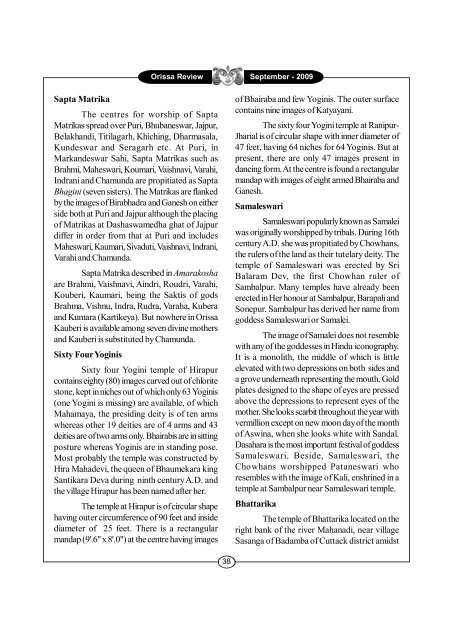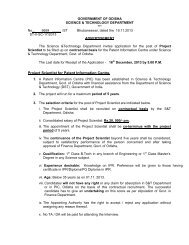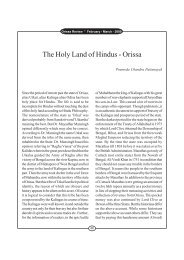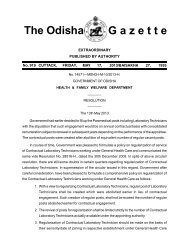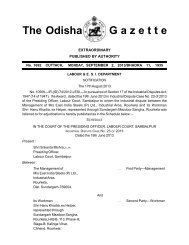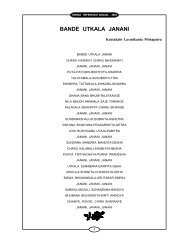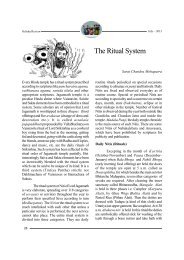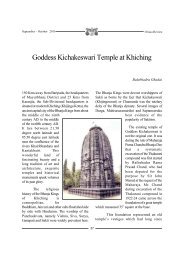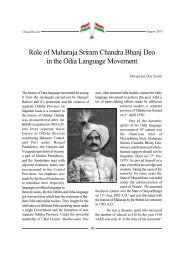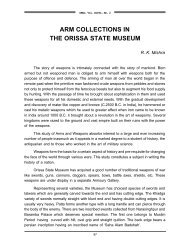The Cult of Saktism in Orissa - Government of Orissa
The Cult of Saktism in Orissa - Government of Orissa
The Cult of Saktism in Orissa - Government of Orissa
You also want an ePaper? Increase the reach of your titles
YUMPU automatically turns print PDFs into web optimized ePapers that Google loves.
Sapta Matrika<br />
<strong>The</strong> centres for worship <strong>of</strong> Sapta<br />
Matrikas spread over Puri, Bhubaneswar, Jajpur,<br />
Belakhandi, Titilagarh, Khich<strong>in</strong>g, Dharmasala,<br />
Kundeswar and Seragarh etc. At Puri, <strong>in</strong><br />
Markandeswar Sahi, Sapta Matrikas such as<br />
Brahmi, Maheswari, Koumari, Vaishnavi, Varahi,<br />
Indrani and Chamunda are propitiated as Sapta<br />
Bhag<strong>in</strong>i (seven sisters). <strong>The</strong> Matrikas are flanked<br />
by the images <strong>of</strong> Birabhadra and Ganesh on either<br />
side both at Puri and Jajpur although the plac<strong>in</strong>g<br />
<strong>of</strong> Matrikas at Dashaswamedha ghat <strong>of</strong> Jajpur<br />
differ <strong>in</strong> order from that at Puri and <strong>in</strong>cludes<br />
Maheswari, Kaumari, Sivaduti, Vaishnavi, Indrani,<br />
Varahi and Chamunda.<br />
Sapta Matrika described <strong>in</strong> Amarakosha<br />
are Brahmi, Vaishnavi, A<strong>in</strong>dri, Roudri, Varahi,<br />
Kouberi, Kaumari, be<strong>in</strong>g the Saktis <strong>of</strong> gods<br />
Brahma, Vishnu, Indra, Rudra, Varaha, Kubera<br />
and Kumara (Kartikeya). But nowhere <strong>in</strong> <strong>Orissa</strong><br />
Kauberi is available among seven div<strong>in</strong>e mothers<br />
and Kauberi is substituted by Chamunda.<br />
Sixty Four Yog<strong>in</strong>is<br />
Sixty four Yog<strong>in</strong>i temple <strong>of</strong> Hirapur<br />
conta<strong>in</strong>s eighty (80) images carved out <strong>of</strong> chlorite<br />
stone, kept <strong>in</strong> niches out <strong>of</strong> which only 63 Yog<strong>in</strong>is<br />
(one Yog<strong>in</strong>i is miss<strong>in</strong>g) are available, <strong>of</strong> which<br />
Mahamaya, the presid<strong>in</strong>g deity is <strong>of</strong> ten arms<br />
whereas other 19 deities are <strong>of</strong> 4 arms and 43<br />
deities are <strong>of</strong> two arms only. Bhairabis are <strong>in</strong> sitt<strong>in</strong>g<br />
posture whereas Yog<strong>in</strong>is are <strong>in</strong> stand<strong>in</strong>g pose.<br />
Most probably the temple was constructed by<br />
Hira Mahadevi, the queen <strong>of</strong> Bhaumekara k<strong>in</strong>g<br />
Santikara Deva dur<strong>in</strong>g n<strong>in</strong>th century A.D. and<br />
the village Hirapur has been named after her.<br />
<strong>The</strong> temple at Hirapur is <strong>of</strong> circular shape<br />
hav<strong>in</strong>g outer circumference <strong>of</strong> 90 feet and <strong>in</strong>side<br />
diameter <strong>of</strong> 25 feet. <strong>The</strong>re is a rectangular<br />
mandap (9'.6" x 8'.0") at the centre hav<strong>in</strong>g images<br />
<strong>Orissa</strong> Review September - 2009<br />
38<br />
<strong>of</strong> Bhairaba and few Yog<strong>in</strong>is. <strong>The</strong> outer surface<br />
conta<strong>in</strong>s n<strong>in</strong>e images <strong>of</strong> Katyayani.<br />
<strong>The</strong> sixty four Yog<strong>in</strong>i temple at Ranipur-<br />
Jharial is <strong>of</strong> circular shape with <strong>in</strong>ner diameter <strong>of</strong><br />
47 feet, hav<strong>in</strong>g 64 niches for 64 Yog<strong>in</strong>is. But at<br />
present, there are only 47 images present <strong>in</strong><br />
danc<strong>in</strong>g form. At the centre is found a rectangular<br />
mandap with images <strong>of</strong> eight armed Bhairaba and<br />
Ganesh.<br />
Samaleswari<br />
Samaleswari popularly known as Samalei<br />
was orig<strong>in</strong>ally worshipped by tribals. Dur<strong>in</strong>g 16th<br />
century A.D. she was propitiated by Chowhans,<br />
the rulers <strong>of</strong> the land as their tutelary deity. <strong>The</strong><br />
temple <strong>of</strong> Samaleswari was erected by Sri<br />
Balaram Dev, the first Chowhan ruler <strong>of</strong><br />
Sambalpur. Many temples have already been<br />
erected <strong>in</strong> Her honour at Sambalpur, Barapali and<br />
Sonepur. Sambalpur has derived her name from<br />
goddess Samaleswari or Samalei.<br />
<strong>The</strong> image <strong>of</strong> Samalei does not resemble<br />
with any <strong>of</strong> the goddesses <strong>in</strong> H<strong>in</strong>du iconography.<br />
It is a monolith, the middle <strong>of</strong> which is little<br />
elevated with two depressions on both sides and<br />
a grove underneath represent<strong>in</strong>g the mouth. Gold<br />
plates designed to the shape <strong>of</strong> eyes are pressed<br />
above the depressions to represent eyes <strong>of</strong> the<br />
mother. She looks scarbit throughout the year with<br />
vermillion except on new moon day <strong>of</strong> the month<br />
<strong>of</strong> Asw<strong>in</strong>a, when she looks white with Sandal.<br />
Dasahara is the most important festival <strong>of</strong> goddess<br />
Samaleswari. Beside, Samaleswari, the<br />
Chowhans worshipped Pataneswari who<br />
resembles with the image <strong>of</strong> Kali, enshr<strong>in</strong>ed <strong>in</strong> a<br />
temple at Sambalpur near Samaleswari temple.<br />
Bhattarika<br />
<strong>The</strong> temple <strong>of</strong> Bhattarika located on the<br />
right bank <strong>of</strong> the river Mahanadi, near village<br />
Sasanga <strong>of</strong> Badamba <strong>of</strong> Cuttack district amidst


